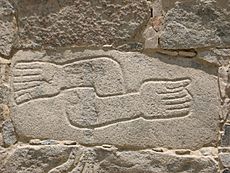Cerro Sechín facts for kids
Cerro Sechín (also known as Sechín de las Estelas) is an ancient archaeological site in the Casma Province of the Ancash Region in northern Peru. This amazing place dates back to about 1600 BC. It was found by Peruvian archaeologists Julio C. Tello and Toribio Mejía Xesspe on July 1, 1937. Tello thought it was the main city of a whole culture, now called the Casma/Sechin culture.
What makes Cerro Sechín special are its huge stone buildings with carved pictures. These carvings show figures in bas-relief, which means they stick out from the stone. They seem to tell stories about important ceremonies or events. Cerro Sechín is part of a bigger area called the Sechin Alto Complex. Other sites like Sechin Bajo and Taukachi-Konkan are also nearby. There is a small museum at the site where you can learn more. The stone carvings at Cerro Sechín might be the oldest large sculptures ever found in the central Andes mountains.
Contents
Where is Cerro Sechín?
Cerro Sechín is built on a granite hill in the Casma Valley. It's about 1 kilometer (0.6 miles) east of the main Pan-American Highway. The site is also about 5 kilometers (3 miles) from Casma, the capital city of the province. It sits about 90 meters (295 feet) above sea level.
The ancient site covers about 5 acres (2 hectares). However, the most important monuments are grouped together in just one hectare (2.5 acres). The area has walled places where people lived and also temple platforms.
The bigger Sechín Complex includes several sites, not just Cerro Sechín. For example, Sechín Alto is to the northeast, by the Sechín river. It is thought to be the largest ancient building complex in Peru, covering 300 to 400 acres (120 to 160 hectares). Sechín Bajo is very close to Cerro Sechín, on the other side of the river. Digs at Sechín Bajo started in 1990. In 2008, they found a deeper layer with a circular plaza made of stone and mud. This plaza dates back to 3,500 BC, making it very old! Taukachi-Konkan is the northernmost site in this complex.
A Look at History
We don't know exactly who built Cerro Sechín or how they did it. We also don't know much about the people who lived there. The site dates to about 1600 BC. This was around the end of the Andean Archaic Period and the start of the Early Formative Period. It was finished before 2000 BC and used until about 1500 BC. This was before the famous Chavín culture began.
After its discovery in 1937, archaeologists like Tello and Xesspe studied Cerro Sechín very carefully. Tello first thought that this monument showed the influence of the Chavín culture. However, later studies found that Cerro Sechín is actually older than the Chavín sites. This means Cerro Sechín might have influenced the architecture and art of the Chavín culture. Experts believe Cerro Sechín was a central place. It was used for managing food, distributing goods, and also as a religious center for ceremonies.
Amazing Architecture
Cerro Sechín has several buildings made from clay and stone. One of the clay buildings was changed three times between 2400 and 2300 BC. On either side of the main buildings are two other structures, called Building A and Building C. There are also two platforms, named after Julio Cesar Tello and Rafael Larco.
The main building is about 51 square meters (549 sq ft) and 4 meters (13 ft) tall. Even though the roofs are gone, we can see their design on ancient pottery. The temple is shaped like a rectangle with rounded corners. It was built using special cone-shaped adobe bricks. The entrance is on the north side. The outer wall, made of large stone slabs or stelae, was built even earlier. A double staircase, about 4 feet (1.2 meters) high, leads to the top of the building.
Mysterious Carvings
The most amazing part of the stone building is its outer wall. It is covered with about 300 carved pictures called bas-reliefs. These carvings show two main types of figures: "warrior-priests" and "victims." The warrior-priests are shown holding a weapon or a special staff. The figures are all humans or powerful beings, with no animals.
Inside the clay building, the main decorations are very well preserved. They show two mythical fish. Another carving shows a person bleeding. These pictures seem to be connected to the sea, rain, and important rituals. The carvings were made using different techniques. Some parts, like the outlines of bodies, have deep, slanted cuts. Other parts, like eyelids and lips, have shallow cuts.
People have many ideas about what these stone carvings mean. One idea is that they show battle scenes. They might have been carved to remember a big battle where foreign warriors won against the local Casma people. Another idea is that the site was a place for studying the human body. This might explain why different body parts, like organs and bones, are shown so clearly. Yet another idea is that the carvings show a big rebellion by the people, which was stopped by the rulers.
Images for kids
See also
 In Spanish: Sechín para niños
In Spanish: Sechín para niños





